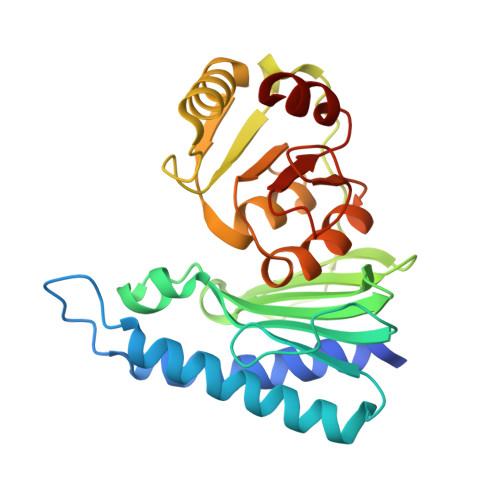Identification and structural characterization of a histidinol phosphate phosphatase fromMycobacterium tuberculosis
Jha, B., Kumar, D., Sharma, A., Dwivedy, A., Singh, R., Biswal, B.K.(2018) J Biol Chem 293: 10102-10118
- PubMed: 29752410
- DOI: https://doi.org/10.1074/jbc.RA118.002299
- Primary Citation of Related Structures:
5YHT, 5ZON - PubMed Abstract:
The absence of a histidine biosynthesis pathway in humans, coupled with histidine essentiality for survival of the important human pathogen Mycobacterium tuberculosis ( Mtb ), underscores the importance of the bacterial enzymes of this pathway as major antituberculosis drug targets. However, the identity of the mycobacterial enzyme that functions as the histidinol phosphate phosphatase (HolPase) of this pathway remains to be established. Here, we demonstrate that the enzyme encoded by the Rv3137 gene, belonging to the inositol monophosphatase (IMPase) family, functions as the Mtb HolPase and specifically dephosphorylates histidinol phosphate. The crystal structure of Rv3137 in apo form enabled us to dissect its distinct structural features. Furthermore, the holo-complex structure revealed that a unique cocatalytic multizinc-assisted mode of substrate binding and catalysis is the hallmark of Mtb HolPase. Interestingly, the enzyme-substrate complex structure unveiled that although monomers possess individual catalytic sites they share a common product-exit channel at the dimer interface. Furthermore, target-based screening against HolPase identified several small-molecule inhibitors of this enzyme. Taken together, our study unravels the missing enzyme link in the Mtb histidine biosynthesis pathway, augments our current mechanistic understanding of histidine production in Mtb , and has helped identify potential inhibitors of this bacterial pathway.
Organizational Affiliation:
From the Structural and Functional Biology Laboratory, National Institute of Immunology, Aruna Asaf Ali Marg, New Delhi, Delhi 110067, India and.


















